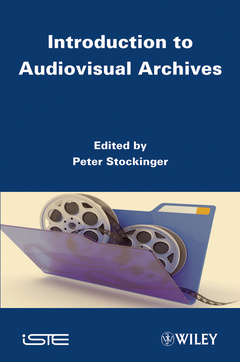Introduction to Audiovisual Archives
Coordonnateur : Stockinger Peter

Today, audiovisual archives and libraries have become very popular especially in the field of collecting, preserving and transmitting cultural heritage. However, the data from these archives or libraries ? videos, images, sound tracks, etc. ? constitute as such only potential cognitive resources for a given public (or "target community"). They have to undergo more or less significant qualitative transformations in order to become user- or community-relevant intellectual goods.
These qualitative transformations are performed through a series of concrete operations such as: audiovisual text segmentation, content description and indexing, pragmatic profiling, translation, etc. These and other operations constitute what we call the semiotic turn in dealing with digital (audiovisual) texts, corpora of texts or even entire (audiovisual) archives and libraries. They demonstrate practically and theoretically the well-known "from data to meta-data" or "from (simple) information to (relevant) knowledge" problem ? a problem that obviously directly influences the effective use, the social impact and relevancy and therefore also the future of digital knowledge archives.
It constitutes, indeed, the heart of a diversity of important R&D programs and projects all over the world.
Introduction xi
Peter STOCKINGER
Chapter 1. Context and Issues 1
Peter STOCKINGER, Elisabeth DE PABLO and Francis LEMAITRE
1.1. The ARA program – a brief historical overview 1
1.2. The scientific and cultural heritage of the ARA program 4
1.3. The working process 8
1.4. Knowledge engineering in the service of the ARA program 14
1.5. The digital environment and the working process 21
1.6. Analyzing an audiovisual corpus using ASW Studio 26
PART 1: THE SEGMENTATION AND DESCRIPTION WORKSHOPS FOR AUDIOVISUAL CORPORA 31
Chapter 2. The Segmentation Workshop for Audiovisual Resources 33
Elisabeth DE PABLO
2.1. Introduction 33
2.2. Segmentation of audiovisual corpora – a general presentation 34
2.3. Appropriation of the segmentation workshop 42
2.4. Some additional thoughts about segmentation 46
2.5. Perspectives relating to the segmentation workshop 46
Chapter 3. Description Workshop for Audiovisual Corpora 49
Muriel CHEMOUNY
3.1. A general overview 49
3.2. The “metadescription” part of an audiovisual analysis in ASW Studio: the mark of the editor’s choice 51
3.3. The “identifying information of an audiovisual resource” part in the ASW description workshop 62
Chapter 4. Analysis of Audiovisual Expression 67
Elisabeth DE PABLO and Jirasri DESLIS
4.1. Introduction 67
4.2. Analysis of the visual shot 68
4.3. Analysis of the sound shot 77
Chapter 5. Analysis of the Audiovisual Content 87
Peter STOCKINGER
5.1. Thematic analysis 87
5.2. A concrete example of the description of a topic 90
5.3. The model of thematic description 98
5.4. The objects of thematic analysis 102
5.5. Procedures of analysis 107
5.6. The different components of a model of thematic description 116
5.7. Libraries of models for the description of subjects 121
Chapter 6. Uses of an Audiovisual Resource 127
Muriel CHEMOUNY and Primsuda SAKUNTHABAI
6.1. The “Uses” part of the ASW description workshop 127
6.2. Producing a linguistic adaptation of an audiovisual resource 135
Chapter 7. Model of an Audiovisual Publication in the form of a Web Portal 143
Jirasri DESLIS
7.1. Introduction 143
7.2. The ArkWork homepage 144
7.3. Thematic access to audiovisual resources 146
7.4. Direct accesses to the audiovisual resources 151
7.5. Access to the audiovisual resources by thesaurus 156
7.6. Contextualization of the video 158
PART 2: TECHNOLOGICAL ENVIRONMENT, DEVELOPMENT AND NEW PERSPECTIVES 169
Chapter 8. The ASW Digital Environment 171
Francis LEMAITRE
8.1. Introduction 171
8.2. General presentation 175
8.3. SemioscapeLibrary 181
8.4. Semioscape 194
8.5. Conclusion 201
Chapter 9. The ASW Studio 203
Francis LEMAITRE
9.1. Introduction 203
9.2. The common libraries 204
9.3. SemioscapeData 207
9.4. ESCoM Update 209
9.5. ESCoM ffCoder 210
9.6. ESCoM OntoEditor 211
9.7. ESCoM-INA Interview 212
9.8. ESCoM SemioscapeAdmin 214
9.9. The ESCoM suite 2011 installer 214
9.10. Semiosphere 216
9.11. Conclusion 220
Chapter 10. The Technical Development of the “Web Portal” Publishing Model 225
Richard GUÉRINET
10.1. The notion of “publishing module” 225
10.2. RIAs 228
10.3. The “Menu” publishing module 233
10.4. The “Video player” publishing module 235
10.5. The “contextualization of a video” publishing module 236
10.6. The “temporal location” publishing module 238
10.7. The “geographical location” publishing module 239
10.8. Conclusion 242
Glossary of Specialized Terms 243
Peter STOCKINGER
Glossary of Acronyms and Names 263
Peter STOCKINGER
Bibliography 281
List of Authors 285
Index 287
Peter Stockinger is Full Professor at the National Institute of Oriental Languages and Civilisations (INALCO) in Paris and also Research Director of ESCoM (Cognitive Semiotics and New Media Research Lab) of the Fondation Maison des Sciences de l’Homme (FMSH) in Paris, France.
Date de parution : 01-2012
Ouvrage de 284 p.
16.3x24 cm



